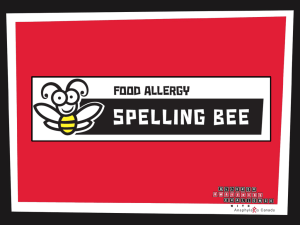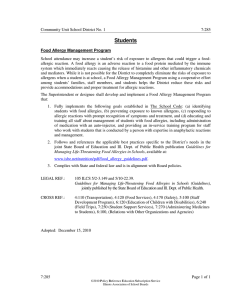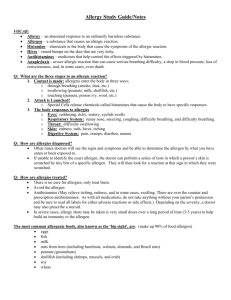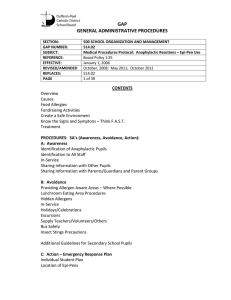Allergy Awareness A learning module for Rose Tree
advertisement
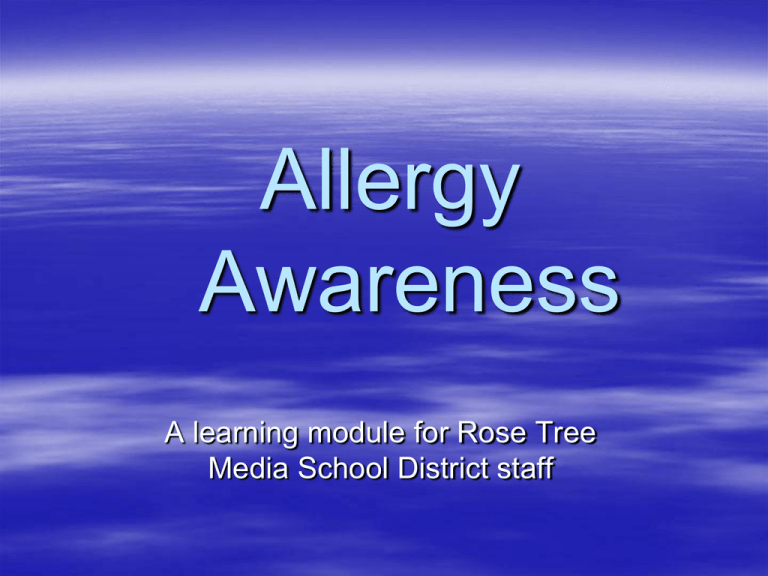
Allergy Awareness A learning module for Rose Tree Media School District staff What is an Allergy ? An allergy is a condition of unusual sensitivity which certain individuals may develop to substances ordinarily harmless. Sensitizing substances are called allergens. Common allergens include: pollens, molds, house dust, animal dander, bee venom, antibiotics and other medications, nuts, peanuts, milk, and shellfish. Others you may not think of include: feathers, chemicals in cosmetics, wood, dyes, perfumes, metal (such as nickel), eggs, wheat, heat, cold, sunlight, and even exercise! Allergens may be taken into the body by: being swallowed; (such as nuts, peanuts, or shellfish) being injected, (such as bee venom) contact on the skin, (such as poison ivy or latex) inhalation, (such as when poison ivy is burned or latex particles become airborne) or bacterial infection in the body. What happens within the body to cause an allergic reaction? When an allergen is taken into the body, the body produces antibodies which react to recognize and attack it. That is why sensitivity often does not happen with the first contact. It may take several exposures for the reaction to occur. The antibodies (specifically antibodies called IgE) attach to mast cells throughout the body. These mast cells release histamines that produce a reaction in sensitive tissues such as eye, nose, skin, respiratory track, digestive track, and cardiovascular system. Who is most likely to develop an allergy? An allergy can develop at any age from birth to death. Children aged 5 to 15 are more apt to develop allergies than older individuals, yet people of any age may experience their first allergy attack—after having lived allergy-free for years. There is a hereditary component to allergic tendency, but anyone can develop an allergy. The 5 most common food allergies in children are: Milk Eggs Peanuts (including products made with peanut oil) Tree Nuts ( such as walnuts, cashews, pecans, etc.) Wheat Soy Treatment for Allergies #1. Removal of the allergen, if possible. #2. Medication such as antihistamines, epinephrine, and others. #3 In some cases, patients opt for desensitization injections With desensitization injections, a tiny amount of the allergen is injected under the skin and is gradually increased over time so that the body can build up resistance. This causes the body to increase production of a different type of antibody called IgG, which recognizes the allergen but doesn’t attach to histamine releasing mast cells. People working in a school district may have responsibility for individuals who have potentially life threatening allergies, so it is important to know how to recognize and manage a serious allergic reaction. What is anaphylaxis or an anaphylactic reaction? It is a sudden, severe, allergic reaction that involves various systems of the body simultaneously. It is a true, lifethreatening emergency! An anaphylactic reaction, if not treated, can quickly lead to anaphylactic shock. When this happens, exposure to the allergen makes blood vessels dilate which rapidly causes a severe drop in blood pressure. It is important to recognize and act quickly during an anaphylactic emergency because the reaction may advance rapidly to respiratory failure, cardio-vascular shock, and sudden death. School district employees such as teachers, bus drivers, and others may be in situations where they will be expected to recognize a severe allergic reaction and deliver emergency treatment in the form of an epi-pen or other prescribed medication. A school district employee, or any person, for that matter, is legally covered under the “Good Samaritan Law” for assisting a victim in an emergency situation. In fact, a person who would fail to assist might be considered negligent. In any event, the consequences of not administering an Epi-pen (or other prescribed medication) to an individual experiencing a life-threatening allergic reaction are unthinkable. Please click on the website below for a video about how to recognize an anaphylactic reaction and use an Epi-Pen auto-injection system. http://www.anaphylaxis .com/~anaphyla/page/ english-cable--how-touse-epipenreg-autoinjector--epinephrine-anaphylaxis If you have questions about allergies, allergic reactions, or administering emergency medication, contact any of the Rose Tree Media School Nurses. We will be happy to offer training and answer questions. Be aware. Be informed. Be prepared to act to save a life.

